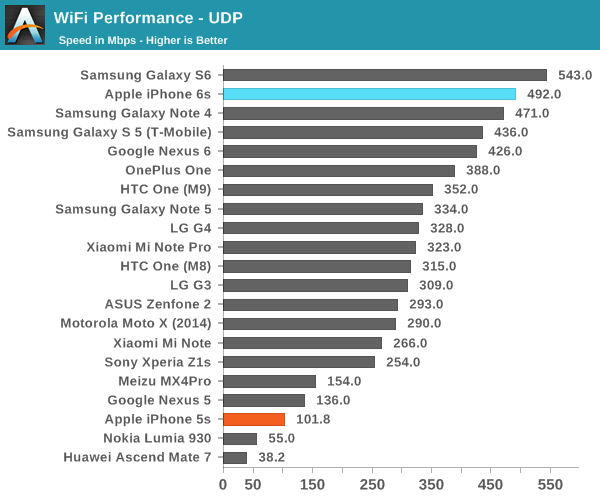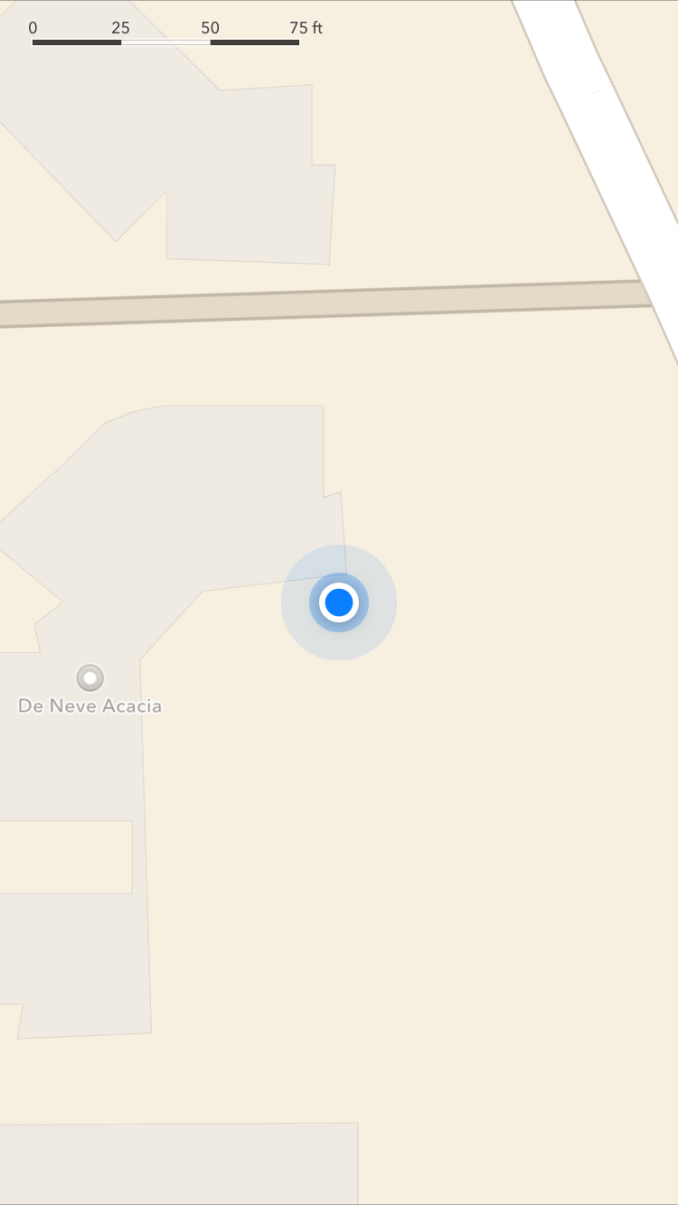The Apple iPhone 6s and iPhone 6s Plus Review
by Ryan Smith & Joshua Ho on November 2, 2015 8:00 AM EST- Posted in
- Smartphones
- Apple
- Mobile
- SoCs
- iPhone 6s
- iPhone 6s Plus
WiFi Performance
While cellular data is often the center of smartphone connectivity, it’s often the case that people rely on WiFi instead of cellular data for the bulk of their data transfers. As a result WiFi is a pretty important part of the overall smartphone experience. In the case of the iPhone 6s, the major change from the iPhone 6 is that rather than single stream 802.11ac, the iPhone 6s now has dual spatial stream 802.11ac. This increases the maximum physical link rate to 867 Mbps. There’s been some confusion over what’s used for the WiFi chipset, and as far as I can tell this is definitely a Broadcom solution, which is identified as BCM4350 in the system judging by the device ID. This chipset is shared with the Macbook, which is probably helpful for driver development. In order to test how well this performs, we use iperf2 in UDP mode to attempt to determine maximum practical bandwidth. It’s worth noting here that the iperf2 ports on iOS are still amazingly buggy though, so these results are no guarantee as far as I can tell.

Interestingly enough, for whatever reason the iPhone 6s holds a minor lead over most of the other devices in this test. I’m not sure what’s causing this, but in practice I found that WiFi on the iPhone 6s worked without any noticeable issues. Reception is noticeably improved when compared to the iPhone 6 due to the addition of a second spatial stream which means that throughput at the same distance is higher.
GNSS
Accurate location is often critical to a number of popular applications for smartphones like any kind of navigation or mapping application, which is going to be an incredibly painful experience if the GNSS system in the phone has poor sensitivity to the signals used in the various GNSS systems available today. Although I have no hard evidence to go on, given the use of a Qualcomm modem in this phone I strongly suspect that this phone is using Qualcomm's IZat location services. I would normally run some cursory testing here with a GPS test application, but because iOS offers no way to clear assistance data and location services are disabled if there is no prior connection to download assistance data, there's no way to do the usual cold lock testing.
A warm lock in which connection was immediately established to begin downloading assistance data achieved lock within 15 seconds, and in general I've never had issues with location services in the iPhone 6s in my time using it.
Misc
Over the course of the review, there are a lot of various bits and pieces that I learn about a phone that might be of interest, but aren’t necessarily examined in intense depth because of either limitations in our testing or the issue of interest isn’t significant enough to examine closely. For example, the fuel gauge appears to be a TI design win as there are references to a BQ27540 chip. The A9 SoC also contains a dedicated AES accelerator for things like full disk encryption and FairPlay DRM. The display backlight appears to use the TI LM3539 driver, but other evidence within the system suggests that this isn’t the only backlight driver for the display.
On the audio side of things, although I haven’t been able to do deep investigations into audio quality it appears in the system that the audio codec used is Cirrus Logic’s CS42L71 which also appears to be responsible for microphone input. However, instead of using an amplified on the audio codec a dedicated amp is used for the speaker, which appears to be a Cirrus Logic CS35L21. Subjectively, the speaker sounds pretty similar to the iPhone 6, but at the high end of the volume range it feels like volume was increased while also increasing distortion. Turning down the volume to a comparable level makes both sound pretty much the same.
More reading of the system files reveals some noticeable codenames like Stockholm which appears to be related to NFC and payments in some way. The fingerprint sensor is referred to as Mesa, and the authentication/secure element appears to be Sand Dollar. The charger chip is referred to either as SN2400 or Tigris. Some sort of accessory detection chip is referred to as TriStar2 or CBTL1610. The ambient light sensor is referred to as CT821 but I can’t find anything on what this is at all.











531 Comments
View All Comments
vFunct - Monday, November 2, 2015 - link
It's probably because they're the best.dysonlu - Tuesday, November 3, 2015 - link
Just like Lance Armstrong was too.vFunct - Tuesday, November 3, 2015 - link
I'm sure a lot of things are best in their category/field.The iPhone just happens to be one of them.
r3loaded - Monday, November 2, 2015 - link
If you now read the rest of the review, you'll find the evidence that supports their claim of being "the best".djsvetljo - Monday, November 2, 2015 - link
After reading the summary, I can't read the rest.ToastyFlake - Monday, November 2, 2015 - link
A leading symptom of fanboyitus.djsvetljo - Monday, November 2, 2015 - link
I am a complete opposite of fan boy. I use daily 2 phones, a BlackBerry10 and Android, equipped my business with ThinkPads and HPs, drive American and Japanese car. Never been a fan boy of anything but strive to get the best FOR MY NEEDS product available at the current time. And everybody has different needs. However, Anandtech (the Apple reviewers at least) doesn't know that. That's is what really bothers me right there. They are trying to tell me - if you want the best phone - get the 6s. Well guess what - you are wrong cause for my needs, it wouldn't last one business week for me.I have been reading their Apple articles for years - they do not compare equally (why they don't try to compare functions that are not present on Apple platforms - [standard] NFC, File Manager, File Sharing, Expansion ports, IR and so on). They have been doing the same thing for years. Same goes for MACs.
Chaser - Monday, November 2, 2015 - link
Maybe Anandtech should write special review just for you that revolves around "YOUR NEEDS". You admit you didn't read the review except the last paragraph but then you have all the time in the world to babble with your baseless tripe. Nice business I'm sure.djsvetljo - Monday, November 2, 2015 - link
Nobody gets it. All they have to do is add "one of" infront of every "the best" and point out the negatives of this phone like a man, not hide them like a mice who's "mother" works for the worship.solipsism - Monday, November 2, 2015 - link
1) They do point out negatives, but as you repeatedly stated, you refuse to read the article (or even use an Apple product).2) Putting "one of" doesn't alter anything in your "FOR MY NEEDS" argument as you made it clear no Apple product will ever last a week for you, so it would still be wrong, based on that. How about this, instead of trying to get the author to write specifically for you, why not try to look at it from the author's PoV or the mass-market PoV?